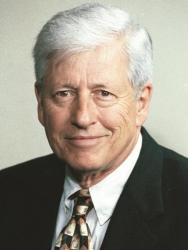Summary
Since the 1970s many economists have accepted the idea of a natural rate of unemployment that describes a unique equilibrium for the real economy. The NAIRU, the empirical counterpart of the natural rate, has become part of the toolkit of policymakers and analysts, especially in the United States. And until the past few years, estimates of a relatively constant natural rate of about 6 percent have fit the actual behavior of the U.S. economy over the previous three decades reasonably well. Since then, however, the persistence of low inflation alongside unemployment rates that have fallen well below 6 percent has led most analysts to conclude that the U.S. NAIRU has fallen. In the first paper of this volume, George Akerlof, William Dickens, and George Perry go further and reject the natural rate model itself.
Over the years there has been considerable controversy about how to model the formation of expectations in empirical work with the natural rate model. The authors, by contrast, see how people use expectations, rather than how they form them, as the key. Rather than accept the standard economic assumption that people make the best use of all available information, the authors turn to a variety of sources for evidence about how people actually use information in making decisions. Supported by this evidence, they develop an alternative to the natural rate model that is based on behavioral assumptions they find more realistic, and that fits the facts better. A striking feature of their model is that, rather than a unique natural rate, it exhibits a range of sustainable unemployment rates consistent with steady, low rates of inflation. The authors show that the lowest unemployment rate in this range is well below the natural rate as usually estimated.
The authors cite psychological studies that have found that decisionmakers “edit” the information available to them, ignoring much that is potentially relevant in order to concentrate on the few factors that matter most. Similarly, studies on the psychology of perception show that an event or stimulus must pass a threshold before it is even perceived, let alone used. In addition, from interviews with compensation professionals, the authors infer that wage setters do not behave as most economic models assume. Rather than choosing a real wage target and then adjusting it fully for expected inflation, they mix information about inflation with a variety of other information relevant to wage setting. And from interviews of the lay public by Robert Shiller and questionnaire studies by Eldar Shafir, Peter Diamond, and Amos Tversky, they find telling evidence about how people perceive and react to inflation. Employees systematically underestimate the tendency of inflation to boost their own nominal wages. Therefore, the authors reason, in periods of moderate inflation, employees’ job satisfaction is likely to be high even if their real wage is unchanged.. They are pleased by their wage increases while not fully recognizing the corresponding rise in prices.
Drawing on these insights, the authors construct a model in which firms pay an efficiency wage and workers respond according to their view of job and wage opportunities outside the firm. The crucial issue is how wage-setting behavior varies with the inflation rate. At any given time, some firms and their workers are fully rational, their wage setting fully incorporating expected inflation. At the same time, other firms or their workers are near rational and their wage setting responds fully to current conditions in their labor market, but less than fully or not at all to expected inflation. Because all firms adjust to current market conditions each time they set wages, the wage level in near-rational firms trails the average wage, but only by a small, and not cumulating, percentage. Prices in all firms are a markup on expected unit labor costs. The authors show that the cost in lost profits from near-rational behavior is negligible at low rates of inflation and grows with the inflation rate. This supports their key hypothesis that the proportion of firms that fully adjust for expected inflation when they set wages will rise with the inflation rate. With little or no inflation, a large fraction of firms will be near rational, not fully adjusting their wages and prices in this way. At successively higher rates of inflation, that fraction will decline, and at a sufficiently high rate of inflation all firms will fully incorporate expected inflation.
The authors present a formal model that derives the implications of this firm-level behavior for the inflation-unemployment relation in the macroeconomy. At zero inflation, rational and near-rational behavior coincide, and equilibrium unemployment is at what would be the conventional natural rate. When steady-state inflation is between zero and some moderate rate, higher inflation is accompanied by lower unemployment. This trade-off reflects two effects working in opposite directions: as the inflation rate rises, firms pursuing near-rational behavior increase employment, but firms shifting to fully rational behavior cut their employment as they shift. In this inflation range, the first effect dominates. Beyond some inflation rate, the second effect begins to dominate and higher inflation is associated with higher unemployment, eventually approaching the conventional natural rate as all firms and workers fully incorporate inflationary expectations. There is thus a point of lowest sustainable unemployment. The natural unemployment rate, which is the rate associated both with high levels of inflation and with zero inflation, is significantly above the lowest sustainable unemployment rate. More generally, operating with an inflation rate either higher or lower than that associated with the lowest unemployment rate leads to excessively high unemployment in the long run. The short-run Phillips curve that follows from this model is one in which the coefficient on expected inflation rises with the inflation rate and approaches unity at sufficiently high inflation rates.
The authors provide empirical support for this form of short-run Phillips curve from U.S. data over the period since the Korean War. They first discuss results reported elsewhere by William Brainard and Perry, who used general Kalman filter estimation that permits all Phillips curve coefficients to vary over time. These authors found little or no variation in the intercept or in the coefficient on unemployment. But the coefficient on lagged inflation, the conventional proxy for expected inflation, did vary over time. Starting from low values in the low-inflation years before the 1970s, it rose to its peak values with the high inflation that accompanied the two OPEC oil price shocks, and then declined again as the inflation rate fell to its recent low levels. Akerlof, Dickens, and Perry present their own results from fitting separate Phillips curves to periods of low and high inflation. To do this they sort the quarters from 1954 through 1999 into two samples: those quarters when the trailing five-year average of inflation as measured by the consumer price index was below 3 percent (or, alternatively, 2.5 percent), and those when it was above 4 percent. The samples have mean inflation rates of 2.0 percent and 6.3 percent, respectively. Using a variety of specifications, the authors then estimate their model with three alternative unemployment measures to allow for different treatment of demographic changes, three measures of price inflation, and a measure of wage inflation. They find the coefficient on inflationary expectations to be consistently and substantially larger in the high-inflation-period regressions than in the low-inflation-period regressions. The authors also report parallel regressions using direct survey measures of inflationary expectations, which avoid the ambiguity over whether lagged inflation is an adequate proxy for expected inflation. These estimates show an even sharper difference between the coefficients on price expectations in the low- and high-inflation periods. All the split-sample least-squares regressions thus support the key hypothesis of the formal model: how price expectations are incorporated into wage setting varies with the inflation rate.
The authors go on to derive an approximation to their model that is tractable for nonlinear estimation. In addition to unemployment and expected inflation, the conventional right-hand-side variables in a Phillips curve, the estimation model includes a term representing how past inflation affects the likelihood that people will act rationally toward expected inflation. To provide a check on the robustness of the results, that term is proxied in a variety of ways. So is expected inflation itself, which is represented by alternative forms of distributed lags on past inflation as well as by the direct survey measures of expected inflation. In addition, the several alternative measures of unemployment and price and wage inflation used in the least-squares regressions are used in estimating the nonlinear model. Finally, whereas the full data period ran from 1954:1 through 1999:4, some of the nonlinear regressions were run only through 1989:4 to ensure that the results are not driven simply by the one long episode of low inflation and falling unemployment in the 1990s. The authors find that the estimates from the nonlinear regressions support the formal model.
The most important result is that nearly all the point estimates indicate that large, sustainable gains in employment are available by operating the macroeconomy at inflation rates moderately above zero. To summarize the range of estimates, for each of their regressions the authors calculate the inflation rate associated with maximum employment and the difference between the corresponding unemployment rate and the natural unemployment rate, which measures the employment gains available. Not surprisingly, the large number of specifications generates a wide range of point estimates. The densest cluster of estimates spans a range from 1.5 to 3 percent for the employment maximizing inflation rate and 0.5 to 3 percentage points for the corresponding unemployment reduction.
The authors discuss in detail four estimated equations that are representative of the range of their specifications, including one that is estimated only through the end of the 1980s. In each case the coefficient on inflationary expectations stays at or near one starting some time after the onset of the inflationary period that began in the late 1960s, and takes on much smaller values during the low-inflation periods before and after. The amount of variation in this key parameter, and the timing of the variations, differ across the specifications, but all support the key prediction of the authors’ model. The employment maximizing rate of inflation for these equations ranges between 1.6 and 3.2 percent. And the difference in employment below the natural rate ranges from 1.5 to 3.1 percentage points.
Although these estimates provide support for the qualitative features of the model, they do not pin down targets for inflation and unemployment. Indeed, it would be unrealistic to seek precise estimates. However, their main results and the departures from conventional natural rate models that they identify appear to be robust and do provide useful guides for econometricians and policymakers. Rather than a unique natural rate of unemployment, the economy has a range of sustainable unemployment rates that are consistent with moderate rates of inflation. For econometricians the main message is that models that assume a unique natural rate are misspecified and will yield misleading estimates of the economy’s potential and the minimum rate of unemployment that is sustainable. For policymakers there are more general guides. Zero inflation is an inappropriate policy target because it raises the sustainable rate of unemployment by an important amount. High rates of inflation are bad for the same reason, as well as because of the distortions and inequities they bring. Moderate rates of inflation, a range that includes the experience of recent quarters when the core CPI has been rising at a 2 percent annual rate, allow the economy to operate with low rates of unemployment and are consistent with a policy seeking to maximize prosperity.
Paper forthcoming in Brookings Papers on Economic Activity, 1:2000





